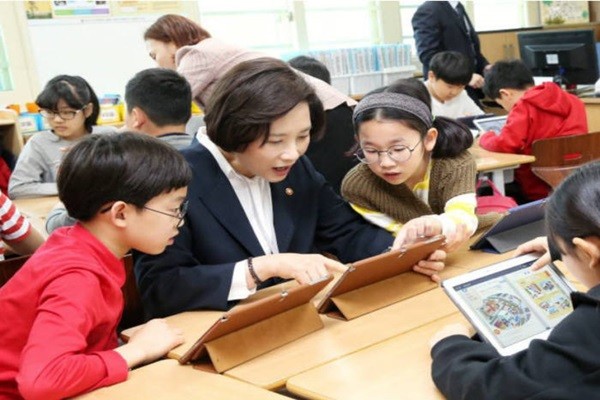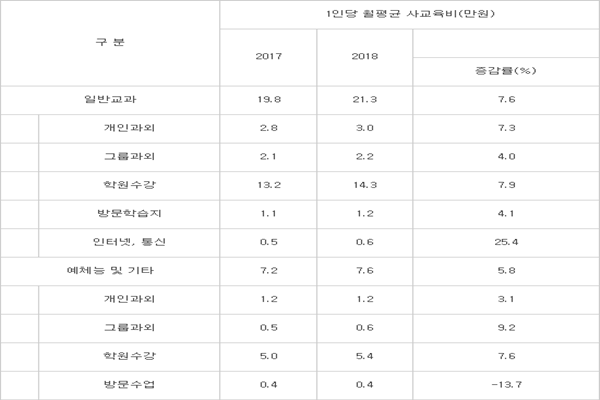While IT environment of public education is at standstill for ten years, private education has made a new leap forward through EduTech. Private education industry, which has constantly changed itself according to digital generation, is currently enjoying its biggest boom. Experts are concerned that difference between public education and private education will only become wider if IT environment of public schools is left alone. Middle class and above in major metropolitan cities are able to easily learn about future education such as maker education, tangible education, and creative education. However, broken homes and families in rural areas have difficult time learning about future education because it is difficult for them to learn about future education even at public schools. South Korean Government led by President Moon Jae-in, who has emphasized publicness of education, can cause wider separation between public education and private education due to its indifference in digital education.
◊Private education industry enjoying its boom
Home-study material market is now based on digital and The Fourth Industrial Revolution technologies. AI (Artificial Intelligence) provides problems that are personalized for a child’s level and helps a child with areas that are lacking. It accumulates and analyzes tens of millions of data daily. It finds and provides videos on YouTube for areas that are not easily understood by a child. Not only AI provides tangible contents that are interesting, but it also provides game-based contents not to bore a child. Home-study material market is also responsible for growth of tablet PC market.
It is estimated that total cost of private education in 2018 was near $16.8 billion (20 trillion KRW). Cost of private education per person was $245 (291,000 KRW) that is the highest ever and 7% jump from that of 2017. It is likely that growth rate and size of private education industry will be enormous when home-study materials that are actively based on Big Data analysis and AI service or private educational institutes are included in statistics.
“A child will not enjoy studying off of a book at a school when he or she is familiar with learning from a tablet PC at home.” said an executive of a publisher. “Public education must provide digital services that are similar to that of private education if public education provides general services.”

◊Lack of general maintenance causing separation between public education and private education
Digital textbooks that are used at public schools receive positive reviews from students and they seem constructed well just like study materials used for private education.
Although digital textbooks that correspond to 2015 curriculum are only available for third grade and fourth grade and social science and science classes for sixth grade, they are expected to be available for other classes gradually.
Ministry of Education examined important future abilities of students before and after using digital textbooks in 2018. Every category such as self-initiated learning ability, creative and innovative ability, ability to utilize information, critical thinking, and confidence in learning earned high score after students used digital textbooks.
However, this is a case only for schools with well-established IT environment. There are many limitations to have every school use digital textbooks. It is possible to have wireless access in at least two classrooms of every school after 2021 due to wireless AP coverage project. This indicates that students will have to move classrooms to use digital textbooks and this is only possible if a school has well-established IT Environment. Teachers will have to manage tablet PCs one by one and download necessary programs. There will not be a solution for network difficulty with wireless connection. Even if a teacher calls a central AS center, it will be difficult for a center that manages every school in South Korea to provide a quick answer. Large realistic contents are only a fairy tale for schools that cannot even provide 100Mbps due to lack of management.
Students from broken homes face difficulty even with receiving an ID. Students who are less than 14 years old need a parent’s signature to receive an ID to use digital textbooks. This is an area that is most difficult for teachers with students from multicultural homes and broken homes. There is nothing that a teacher can do if a student loses his or her password. Situation is same even if a student receives an ID for various portal sites such as Google to access various contents. Personnel and system that will manage school network and digital textbooks systematically are not in place.
◊Next-generation education systems also worry educational institutions
South Korean Government is planning to establish fourth-generation NEIS (National Education Information System) in 2022 by applying new policies. It is going to invest $1.68 million (2 billion KRW) by October of this year to establish ISP (Information Strategy Planning). It also formed a task force comprised of experts in school administration. It is going to establish next-generation EduFine System in 2020.
EduFine System is used for five to ten years once it is established. This indicates that EduFine System needs to consider environment of future users first. Ministry of Education once stated that it would change EduFine System into an information system centered on users and it is planning to lessen burdens for teachers by enhancing business programs and accommodating learning management and tasks involving school administration.
However, it seems that South Korean Government is not considering about changing education environment into participation-type and sharing-type environment. South Korean Government is restrictively considering Cloud, which is the basis of participation-type class, and it is causing security concerns.
“While there needs to be Cloud environment so that central system can manage education system systematically, there is nothing that has changed from a central system to school network.” said a representative for a South Korean educational institution.
Staff Reporter Mun, Bokyung | okmun@etnews.com
